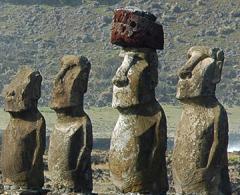
This Article From Issue
September-October 2006
Volume 94, Number 5
Page 411
DOI: 10.1511/2006.61.411
This roundup of notable recent items about scientific research, culled from news reports, was compiled from free electronic newsletters produced by Sigma Xi's Public Understanding of Science program.
White Blood Cells Transfer Mouse's Resistance to Cancer
The accidental discovery three years ago of a mouse that is immune to cancer was startling by itself. Now the scientists who originally identified that animal and bred others from it (dubbed "spontaneous regression/complete resistance" or SR/CR mice) have successfully transferred that resistance to normal mice by infusing them with white blood cells from the SR/CR strain. The treated mice retain cancer resistance for long periods by a mechanism that still remains unknown.
Hicks, A. M. et al. Transferable anticancer innate immunity in spontaneous regression/complete resistance mice. Proceedings of the National Academy of Sciences of the U.S.A. 103:7753–7758 (May 16)
Lessons Pay Off for Meerkat Pups
Zoologists have discovered that adult meerkats, small South African members of the mongoose family, teach their pups how to eat dangerous animals. When the offspring are quite small, adults bring them dead animals (such as scorpions, lizards and spiders) on which to practice. Then, as the pups get older, they are given disabled prey. An adult might, for example, bite off the stinger of a scorpion before presenting it to a pup. Eventually, the juvenile graduates to handling normal, live prey. In tests, young meerkats that gained experience wrangling scorpions in this way are more capable than those that had practiced only on dead scorpions or boiled eggs, which were used as a control.
Thornton, A., and K. McAuliffe. Teaching in wild meerkats. Science 313:227–229 (July 14)
Protein Enhances Transfer of Pluripotency
Stem cells are said to be "pluripotent": They can develop into any type of tissue in the body and thus hold great promise in treating spinal cord injury, Parkinson's disease and other chronic disorders. But obtaining embryonic stem cells requires the destruction of human embryos, so research in this area raises serious ethical concerns. New work identifies a protein (called Nanog) that promotes the creation of pluripotent cells from the fusion of a stem cell with a more specialized adult cell, such as a neuron. This line of research may one day lead to methods that allow adult cells to be converted to a pluripotent state without the use of stem cells at all.
Silva, J., et al. Nanog promotes transfer of pluripotency after cell fusion. Nature 441:997–1001 (June 22)
Anti-Allergy Drug Fights Malaria
Tests in mice reveal that astemizole, a drug developed to treat allergies, kills the malaria parasite with high efficacy. Astemizole is already licensed for use in people, so it could be rapidly approved for use against malaria. And because the drug is no longer under patent, the cost could be kept low.
Chong, C. R., et al. A clinical drug library screen identifies astemizole as an antimalarial agent. Nature Chemical Biology 2:415–416 (August 1)
Earliest Cultivar May Be the Fig
Near the city of Jericho in the West Bank, a team of two archaeobotanists and an archaeologist have discovered what may be the earliest traces of human agriculture. The charred remains of nine small figs, found in the ruins of a burned building, are estimated to be 11,400 years old. This variety of fig probably bore sweet fruit but no fertile seeds, and thus it could have survived only through artificial cultivation. Wheat, barley and chickpeas had previously been thought to be the first crops, but these figs predate those examples of early agriculture by a millennium.
Kislev, M. E, et al. Early domesticated fig in the Jordan Valley. Science 312:1372–1374 (June 2)
Tiny Black Holes May Pervade Space
Most people think of black holes as supermassive objects, the remnants of collapsed stars whose powerful gravity devours all nearby matter. But some theories suggest that these strange objects may be much more common—and much closer to home—than had been thought. The solar system, for example, may contain 3,000 to 300,000 of these objects at a given time, some of them floating inside the orbit of Mars. New work suggests that such objects would produce interference fringes in the energy spectra of gamma-ray bursts, a prediction that soon should be able to be tested.
Keeton, C. R., and A. O. Petters. Formalism for testing theories of gravity using lensing by compact objects. III. Braneworld gravity. Physical Review D 73:104032 (May 24)
Split Between Human and Chimp Lineages Was Protracted
New genetic analyses indicate that the final split between the earliest humans and chimpanzees occurred at most 6.3 million years ago and probably less than 5.4 million years ago. To reconcile this result with fossil evidence (which puts the time of divergence at least a million years earlier), scientists suggest that early hominids and chimps must have interbred for some period of time before a final split occurred.
Patterson, N., et al. Genetic evidence for complex speciation of humans and chimpanzees. Nature 441:1103–1108 (29 June)
Avian Flu Entered Nigeria Thrice
In February, health officials reported an outbreak of avian flu at a large farm in southwest Nigeria where chickens, geese and ostriches were being raised. The virus also turned up at two other places in that country. Molecular biologists have now compared genetic information obtained in all three locations and determined that the outbreaks stemmed from three distinct viral strains, ones genetically similar to those discovered in earlier outbreaks in Egypt, Russia and Mongolia.
Ducatez, M. F., et al. Multiple introductions of H5N1 in Nigeria. Nature 442:37 (July 6)

American Scientist Comments and Discussion
To discuss our articles or comment on them, please share them and tag American Scientist on social media platforms. Here are links to our profiles on Twitter, Facebook, and LinkedIn.
If we re-share your post, we will moderate comments/discussion following our comments policy.